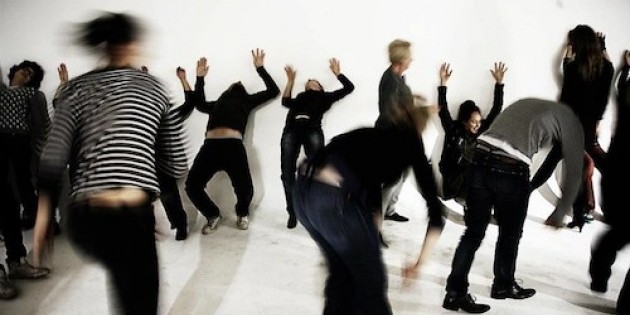Richard Siegal, from Paris: An Interview with Ann Moradian

"If/Then Dialogues"
Richard Siegal, An Interview
March 2010, Paris, France
©Ann Moradian,for The Dance Enthusiast
I was first introduced to Richard Siegal's work last fall in Paris at the Arts Arena. The program, If/Then Dialogues, took place at The Door Studios' intimate loft space near the Bastille. What I experienced could be described as a design in movement architecture that invited the audience to engage not only with Siegal, but also with each other through gesture and movement.
By the end of the night, buoyed lightly with champagne, at least 80% of the audience shifted from verbal to physical 'conversation.' The evening was a powerful affirmation of our humanity, our vulnerability and our interconnectedness.
I was surprised to discover that a precise control system, which Siegal calls his If/Then Methodology, served as the foundation for much of his choreographic work.
The movement and gestural phrases are predefined. The choreographic score is written like a flowchart that meticulously notes the range of possibilities the dancers can choose from, and what possibilities remain open to them based on the choices they make. Essentially, "If I do x, then you do y (or z, or q)." The range of possibilities is very clearly outlined, demanding a mnemonic virtuosity on the part of the performers.
.jpg) |
| Richard Siegal at DOOR STUDIOS, Paris - Photo ©Alessandro Capoccia |
I was surprised to discover that a precise control system, which Siegal calls his If/Then Methodology, served as the foundation for much of his choreographic work.
The movement and gestural phrases are predefined. The choreographic score is written like a flowchart that meticulously notes the range of possibilities the dancers can choose from, and what possibilities remain open to them based on the choices they make. Essentially, "If I do x, then you do y (or z, or q)." The range of possibilities is very clearly outlined, demanding a mnemonic virtuosity on the part of the performers.
Control systems are, let's face it, about control.
So, I had to wonder 'What happens if... someone breaks the rules?'
.jpg) |
| Richard Siegal at DOOR STUDIOS, Paris - Photo ©Alessandro Capoccia |
Siegal's response is "Yes, at what point does a system break down or implode? You can bore people,to the point that they stagnate. Or you can confront them, corner them, frustrate them... until there is an implosion and the realignment of an idea.”
The first time he worked with his method in 2005, he found that he was too controlling. The dance, If/Then, was "an execution of the system" and it left little room for interpretive expression on the part of the dancers who were (at the time) Janis Brenner and Jeanine Durning. The frustration they felt served as feedback to the 'system.' As in all systems, the feedback pointed toward possibilities for improvement that were integrated later on.
"There is an interesting incompatibility," Siegal says. "Human nature and systems may at times seem to be in opposition." He thought the DVD he made in 2010, also called If/Then Dialogues, was a eulogy to that methodology and exploration. He thought that he was done with it.
But something "uncoupled" during its' use for the Venice Biennale of Architecture, and Siegal discovered hat human nature and his system could co-exist although, Siegal still l points out, "It became important not to be a slave to the system."
But something "uncoupled" during its' use for the Venice Biennale of Architecture, and Siegal discovered hat human nature and his system could co-exist although, Siegal still l points out, "It became important not to be a slave to the system."
 |
| Richard Siegal at DOOR STUDIOS, Paris - Photo ©Alessandro Capoccia |
I wondered what had propelled Siegal, both consciously and unconsciously, to create his methodology.
His conscious intent was "to emancipate the dancer and contradictorily stake my claim as a choreographer. John Cage and Merce Cunningham imagined an art that eradicates the prejudices of the creator," and I participate in that desire," Siegal asserts, " But the relationship between dancer and choreographer is less clear-cut than it used to be. Choreographer and dancer, now, are often mutually responsible for the product. The If/Then methodology began as an attempt to resolve some of the inequities in this relationship."
His conscious intent was "to emancipate the dancer and contradictorily stake my claim as a choreographer. John Cage and Merce Cunningham imagined an art that eradicates the prejudices of the creator," and I participate in that desire," Siegal asserts, " But the relationship between dancer and choreographer is less clear-cut than it used to be. Choreographer and dancer, now, are often mutually responsible for the product. The If/Then methodology began as an attempt to resolve some of the inequities in this relationship."
Not only does Siegal aim to provoke a response from his dancers, he also wants provoke a response from the audience, as in performance art or action art.
Certainly the program I saw at The Door Studios provoked. Siegal's earlier solo Stranger was a one-on-one performance that he describes as a "kind of violence"; a confrontation with the role of the audience, and a demand that the audience take responsibility for their part in the creation of their theatrical experience.
"The response, " says Siegal, "whatever it is is the thing I am looking for."
 |
| Richard Siegal at DOOR STUDIOS, Paris - Photo ©Alessandro Capoccia |














